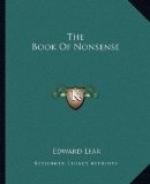The history of Lear’s choice of a career was a curious one. He was the youngest of twenty-one children, and, through a family mischance, was thrown entirely on the limited resources of an elderly sister at a very early age. As a boy he had always dabbled in colors for his own amusement, and had been given to poring over the ordinary boys’ books upon natural history. It occurred to him to try to turn his infant talents to account; and he painted upon cardboard a couple of birds in the style which the older among us remember as having been called Oriental tinting, took them to a small shop, and sold them for fourpence. The kindness of friends, to whom he was ever grateful, gave him the opportunity of more serious and more remunerative study, and he became a patient and accurate zooelogical draughtsman. Many of the birds in the earlier volumes of Gould’s magnificent folios were drawn for him by Lear. A few years back there were eagles alive in the Zooelogical Gardens in Regent’s Park to which Lear could point as old familiar friends that he had drawn laboriously from claw to beak fifty years before. He united with this kind of work the more unpleasant occupation of drawing the curiosities of disease or deformity in hospitals. One day, as he was busily intent on the portrait of a bird in the Zooelogical Gardens, an old gentleman came and looked over his shoulder, entered into conversation, and finally said to him, “You must come and draw my birds at Knowsley.” Lear did not know where Knowsley was, or what it meant; but the old gentleman was the thirteenth Earl of Derby. The successive Earls of Derby have been among Lear’s kindest and most generous patrons. He went to Knowsley, and the drawings in the “Knowsley Menagerie” (now a rare and highly-prized work among book collectors) are by Lear’s hand. At Knowsley he became a permanent favorite; and it was there that he composed in prolific succession his charming and wonderful series of utterly nonsensical rhymes and drawings. Lear had already begun seriously to study landscape. When English winters began to threaten his health, Lord Derby started a subscription which enabled him to go to Rome as a student and artist, and no doubt gave him recommendations among Anglo-Roman society which laid the foundations of a numerous clientele. It was in the Roman summers that Lear first began to exercise the taste for pictorial wandering which grew into a habit and a passion, to fill vivid and copious note-books as he went, and to illustrate them by spirited and accurate drawings; and his first volume of “Illustrated Excursions in Italy,” published in 1846, is gratefully dedicated to his Knowsley patron.




